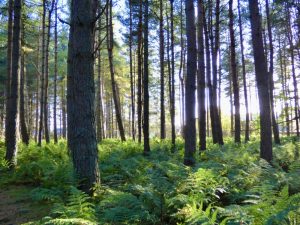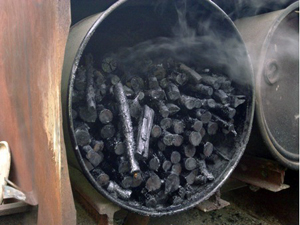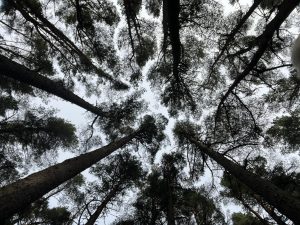Woodland and forest cover

Compared to some of our European neighbours, it seems that our percentage woodland and forest cover is quite low at 13%; as was recently discussed on the BBC "More or less" programme. Only Denmark and the Netherlands have similar low levels of cover. Finland, on the other hand, has almost three quarters of its surface area covered with trees. After the end of the last ice age, trees gradually recolonised the exposed landscape so that vast swathes of the U.K. were covered with woodland/forest - the wildwood.
It might be thought that our current low figure is due to increased urbanisation, road/motorway construction etc. In fact, the tree cover is remarkably similar to that at the end of the first millennium CE. More trees were ‘lost’ in succeeding centuries with the expansion of farming, and trees were harvested for boat building and house construction. The Mary Rose was built using oak and elm. It was the first big ship of the Tudor naval fleet. It has been estimated that over 600 trees were needed for its construction; that is equivalent to about 16 hectares of forest/woodland.
Wood was also used to produce charcoal, which was used to smelt metals, particularly iron.  The history of charcoal burners in the New Forest is well documented. Many woodlands / forests were the preserve of the landed gentry and the aristocracy and reserved for deer hunting. Anyone caught killing deer or boar from such woodlands could suffer terrible punishments but would more likely be fined..
The history of charcoal burners in the New Forest is well documented. Many woodlands / forests were the preserve of the landed gentry and the aristocracy and reserved for deer hunting. Anyone caught killing deer or boar from such woodlands could suffer terrible punishments but would more likely be fined..
Woodland and forest continued to be depleted so that by the end of the seventeenth century, the percentage cover had fallen to 8%. At the beginning of the twentieth century, the figure stood at a pitiful 5.2%. The Asquith administration in 1916 established a committee to report on the country’s woodlands and timber supplies. This lead to the setting up of the Forestry Commission which was not just concerned with established ‘strategic reserves of timber’ but also trying to create viable communities in marginal areas.
 Through its efforts over the succeeding decades, the U.K’s area of woodland and forest has increased significantly - though the Forestry Commission’s heavy use of coniferous species (particularly in the 60’s and 70’s) has been criticised. Coniferous woodland / plantations do not support such a wide range of plant and animal life as deciduous woodland. However, their current emphasis on diversity (and recreational use) favours a much wider range of species, including broadleaved/deciduous trees and the development of a richer ground flora.
Through its efforts over the succeeding decades, the U.K’s area of woodland and forest has increased significantly - though the Forestry Commission’s heavy use of coniferous species (particularly in the 60’s and 70’s) has been criticised. Coniferous woodland / plantations do not support such a wide range of plant and animal life as deciduous woodland. However, their current emphasis on diversity (and recreational use) favours a much wider range of species, including broadleaved/deciduous trees and the development of a richer ground flora.
Comments are closed for this post.
